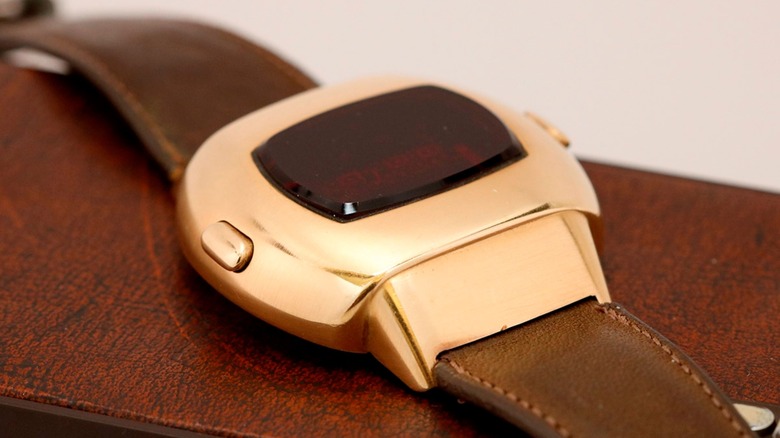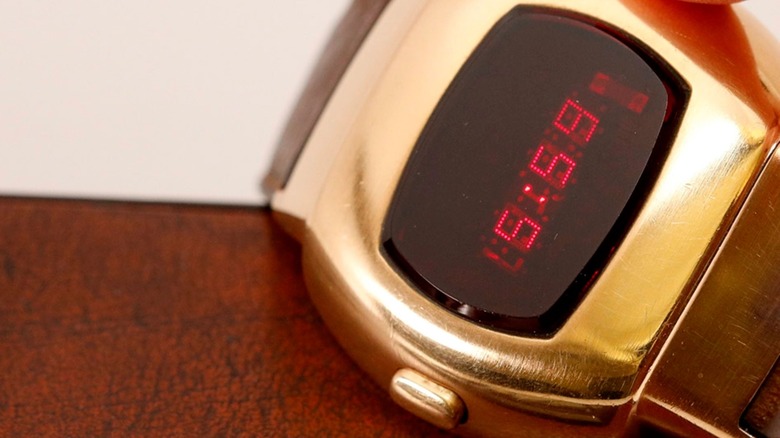Before Smartwatches, There Was The Hamilton Pulsar Time Computer
These days, smartwatches are almost ubiquitous. While they didn't explode onto the market with quite the same success as smartphones, many of us now walk around with a smartwatch of some kind on our wrist. The "watch" function of most smartwatches is actually among their least impressive features — they can track our activity, relay text messages, tell us when to breathe, tell us when we're breathing too much, and tell us when our laundry is done.
But before the modern smartwatch came another horological revolution, all the way from Pennsylvania. Launched in 1972, the Hamilton Pulsar Time Computer was a watch, but not as we knew it. It was digital with a bright red, space-age LED display. The first-of-its-kind watch had its origins in prop timepieces that Hamilton had produced for Stanley Kubrick's era-defining 1968 movie "2001: A Space Odyssey," and as you'd expect from the product of a movie that predicted tablet computers, the Pulsar looked pretty futuristic.
Largely forgotten now outside of horology circles, at the time it was launched, the Pulsar was truly groundbreaking — and also controversial. Legendary TV host Jimmy Carson famously tossed a prototype Pulsar with its 18-carat gold case over his shoulder when he learned how much it cost: $2,100 in 1970 (equivalent to more than $15,000 now). Luckily, Hamilton designed the Pulsar to withstand shocks of more than 2,500 times the force of gravity — an amount of force that would, of course, have reduced its unlucky wearer to soup. But its Johnny Carson-resistant case wasn't the only thing that made the Pulsar special.
What was the Pulsar Time Computer?
To really appreciate the importance of the Pulsar, it's important to understand the turmoil that was going on in the watch industry of the early '70s. The development of inexpensive, highly accurate quartz-regulated watch mechanisms transformed horology. The best mechanical watches might gain or lose +/- 10 seconds a day, whereas even a fairly cheap quartz model will typically lose or gain less than that in a month. So why would anyone spend money on an expensive mechanical timepiece?
The so-called "Quartz Crisis" threw traditional watchmakers into a tailspin, and nowadays it's remembered as a primarily Japanese success story. But things could have been very different — arguably, it was Hamilton, an American manufacturer, that really embedded quartz watches in the public consciousness with the futuristic Pulsar, which introduced the world to a brand new concept: a digital time display.
The Hamilton Watch Company was founded in Lancaster, Pennsylvania, and by the time Carson threw its latest prototype over his shoulder, it had been making watches since the late 1800s. It was also in serious financial trouble. The Pulsar was a risky bet for the struggling watchmaker. Rather than a conventional dial with hour, minute, and seconds hands, the Pulsar had no moving parts, and its "face" was a flat, dull red synthetic ruby "time screen." Normally the screen was blank, but at the press of a button, LED characters lit up to display the time digitally, in hours and minutes. A long press of the same button would display seconds. When John Bergey, head of research and development at Hamilton Watch Co., went on "The Tonight Show" in 1970 to show off the prototype Pulsar, he really needed a win. Despite the host's reaction, he got one.
The Legacy of the Pulsar
Hamilton was far from the first manufacturer to release a quartz watch, but nevertheless, the Pulsar was an instant hit. It looked like nothing else on the market, it had a cool space-age-sounding name, and for a season in the 1970s, it could be seen on the wrists of the great and the good (and the not so good) all over the world. Famous Pulsar-owners included Elton John, Elvis Presley, the Shah of Iran, and U.S. President Gerald Ford. Even James Bond wore one in Roger Moore's 1973 franchise debut "Live and Let Die."
So why aren't we all still sporting Pulsars in 2023? The reality is that while they looked amazing, those original LED displays were notoriously power-hungry, and the time-on-demand interface was inconvenient compared to the always-on display of a conventional watch face. Later LCD displays were far more practical, but let's be honest, they were nowhere near as cool. The good news is that the Pulsar isn't dead. In 2020, Hamilton (now owned by Swiss watch giant Swatch Group) released an updated version of the Pulsar, now with an always-on display. The 2020 Hamilton PSR isn't an exact reproduction of the original, but at less than $800, it's a lot more affordable.
The Hamilton Pulsar Time Computer was truly a watch of its time. It embodied the spirit of the space age and presaged the era of techno-materialism that would follow in the 1980s — and just possibly, if it weren't for the Pulsar, with its innovative design and revolutionary digital display, the modern smartwatch wouldn't exist.

